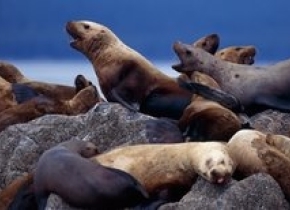

海狮和海豹已成为乌拉圭的一大旅游热点,但它们对人的接受度也日益降低。
撰稿:詹森·古德曼Jason G. Goldman
翻译:张心茹
审校:潘磊
Cabo Polonio is a small seaside village on Uruguay's Atlantic coast. The permanent, year-round population is just 95 people living in around 50 homes. Another 350 homes are used between December and February—by tourists hoping to see pinnipeds—
—fur seals and sea lions that haul out on the town’s rocky cape.
乌拉圭的卡波波罗尼奥是坐落于大西洋海岸的一个海边村庄。整年的永久居民只有95人,大概50户。而当地另外的350套房屋则是供游客在12月到2月间居住——游客们为看游弋在村庄石滩的海狮、海豹等鳍足动物而来。
In January alone, more than 30,000 tourists visit. What are the impacts of so many tourists on these marine mammals? Between 1996 and 2014, European and South American biologists monitored both the animals and the people to find out.
仅在1月就有超过3万名游客到访此地。如此多的游客对这些海洋哺乳动物产生什么影响?在1996到2014年间,来自欧洲和南美的生物学家对动物和人都进行了观测,想要探明这个问题。
Over that time span, the pinnipeds' tolerance for human disturbance declined. When annoyed, they move further away from the tourist viewing area or even dive back in the water to swim away. Those responses are contrary to the common assumption that wildlife becomes habituated to human activities. The study is in the journal Applied Animal Behaviour Science. [Carme Tuneu Corral, et al., Short- and long-term changes in the intensity of responses of pinnipeds to tourist approaches in Cabo Polonio, Uruguay.]
在那段时间里,鳍足类动物对人类干扰的容忍度降低。一旦被激怒,它们会立刻远离游客观赏区,甚至潜到水下游走。这些反应与野生动物会渐渐适应人类活动的常规设想相悖。这项研究被收录于应用《动物行为科学》(Applied Animal Behaviour)杂志。
The researchers think that a fence, initially constructed in the late 1990s, is to blame. It was built with good intentions, to keep people a safe distance from the colony. But the fence isn't long enough to keep people away from the most critical part of the habitat. It might even funnel people towards that area, as they try to find viewing spots closer than the fence would allow.
研究者认为应该归咎于20世纪90年代末期建造的围栏。建立围栏是出于好意,为保持人群与动物之间的安全距离。但围栏不够长,没能将人群拦在鳍足类动物栖息地的核心区域外。甚至反而引导人们蜂拥到那些核心区域。人们总想越过围栏范围,去到更近的观赏位置。
Or it could be that the fence actually does its job keeping people away. But as a result, they are just far enough away that the animals never really get used to them.
可以说,围栏确实达到了阻止人们靠近的目的,但它们只是距离足够远,以至于动物从未真正习惯它们。
The truth is that pinnipeds seem to be doing well in Uruguay. While the amount of animals in the rookery varies day by day, the best estimate is there's now around a thousand of them—more than there were 20 years ago. But it's hard to say whether tourism has played any role in that increase. The animals have also become protected from hunting under Uruguayan law. And there are environmental factors at play in governing their population, like prey availability and climate change.
事实上,乌拉圭的鳍足类动物表现已经不算抵触。虽然每天石滩上的动物数量有所不同,但最优估计结果约有一千只,比20年前多。很难说旅游业在这一增长中是否发挥了什么作用。这些动物受乌拉圭法律保护,不能被猎杀。类似捕食难度和气候变化等环境因素会控制它们的数量。
Still, the study tells us two things. First, photographic wildlife tourism may not always be as low-impact as assumed. Second, ecotourism developers should get input from social psychologists: who can help anticipate the behaviors of the visiting humans, as they observe the behaviors of the native wildlife.
但这项研究还是告诉了我们两件事,首先以拍摄野生动物为热点的旅游业不总是同想象中仅有很小的影响。其次生态旅游的开发者需要听取社会心理学家的意见,他们能预见游客在观察野生动物时的一些行为。
 京公网安备11010502039775号
京公网安备11010502039775号